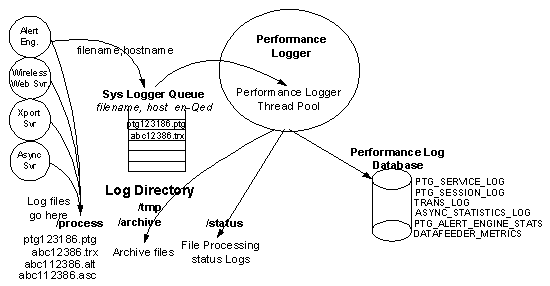| Oracle9iAS Wireless Administrator's Guide Release 9.0.3 Part Number B10042_01 |
|
|
| Oracle9iAS Wireless Administrator's Guide Release 9.0.3 Part Number B10042_01 |
|
|
The Oracle9iAS Wireless Performance Manager provides system administrators with information on the running status of Wireless Web Server, alert engine, message gateway server, data feed engine, and the async server. The Performance Manager also provides statistical information, enabling system administrators to study past performance and historical data to perform future trend analysis.
Wireless integrates with the OEM (Oracle Enterprise Manager) framework to provide a web-based monitoring tool which displays metrics for diagnosis based on the data logged.
The Activity Logger provides the common logging framework used by the runtime components. Database logging is handled asynchronously because the runtime logging on the database carries a huge overhead. The runtime data is generated as files, which are less expensive. The data thus generated is picked up by the Performance Logger framework and written onto the database. In this way, database logging is handled asynchronously without impacting the runtime performance of the respective servers.
For the Wireless web server, the logging process is handled in the callback of the different events, which are generated (that is, the session begin and end). These events are enabled by default for logging purposes. If the administrator chooses not to generate the logging, then there is a provision to turn off the Wireless web server logging. When this happens, the callbacks do not generate log files. For other modules, such as the Alert Engine, Async Server, and Transport Server, logging into the files occurs when the corresponding request is fulfilled. The Data Feeder logs the runtime data directly to the database in batches.

The generated log files follow a common directory structure, which can be configured using the system management functions at the node (process) level. The top level Logging Directory is specified here, the Logger Framework, which all modules use, creates sub-directories: process, status and archive. At runtime, the log files generated by the different modules have distinct file suffixes. These files are stored in the process directory and the file names and the machine name are enqueued into a `SYS_LOGGER_QUEUE'. The file can be made available for processing based on a configurable file size. Additionally, Wireless supports log file aging by which the log file is automatically made available for processing after a fixed time. This ensures that the skew introduced by the asynchronous nature of the logging process is reduced. The log file age (also known as close frequency) can be configured using the system management functions for the site-level configuration of the Performance Logger.
The modules (which generate these log files with distinct suffixes), provide a Database Log File Handler Class, which processes these files. The handler classes are created by extending a common abstract class, which provides the connection and directory and file information. The handler to suffix mapping is pre-seeded in Wireless during installation.
Starting Performance Logger starts up multiple threads, each containing an instance of the different handlers. Each logger thread dequeues the filenames belonging to the local machine, inspects the file suffix and delegates it to the corresponding handler class for further processing.
The administrator can control the number of Performance Logger threads using the system management functions for the process-level configuration.
For details regarding the Performance Monitor configuration see Section 12.1.5 in Chapter 12, "Server Configuration".
|
Note: Since these tables tend to grow during the life of the servers, the administrator may choose to purge the data off these tables periodically. |
The System Logger logs the runtime debug log information generated by the runtime processes. The Wireless server generates log information, which is stored in the log file. The different levels of logging and the log file size can be configured as follows:
To configure the System Log file using Wireless Management at either the site or process level:
This pattern enables you to identify the log file generated by the different server processes. Currently, the only supported pattern is <filename>{0}.log. For example, sys_panama{0}.log would generate a file with a name sys_panama<timestamp in long>.log. Using this pattern enables administrators to identify log files pertaining to the different server processes based on their start timestamp. The setting of the pattern is optional. The default log file name sys_panama.log
At the Wireless server or host level, the log directory may be specified using Wireless Management. The default log directory is the default temp directory for that operating system (typically c:\temp for windows and /var/tmp on UNIX).